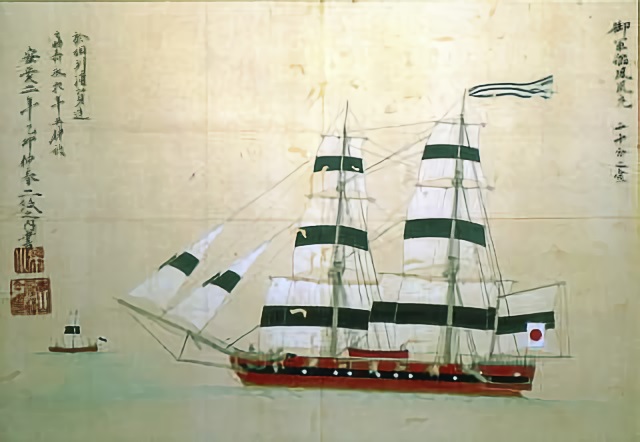Color lithograph: Passing the Rubicon. Lieut. S. Bent in the Mississippi’s first cutter forcing his way through a fleet of Japanese boats while surveying the Bay of Yedo, Japan, July 1853.
“Concerning strange lands, all things are fixed at Nagasaki, not here in (Edo) bay; therefore, you must depart as quickly as possible and not come any more to Japan.” Seven years later, Cmdre. Perry succeeded in “opening” Japan, the “Hermit Kingdom,” to the West.
Excerpted from Carroll Storrs Alden, Professor, Dept. of English, U. S. Naval Academy (Dec. 1924 Proceedings, Vol. 50/12/262)

Washington, D.C. Stephen Bleecker Luce began his naval career in 1841, when at the age of fourteen he was appointed midshipman and ordered to report on the receiving ship at New York. Four years later, when attached to the Columbus, he accompanied the first expedition to Japan. The American Commissioner to China, having negotiated a treaty between the United States and China, in his enthusiasm had written to the President suggesting that the same might be done with Japan.

In response Commodore James Biddle was sent out in 1845 with the Columbus, eighty guns, and the Vincennes, twenty guns, under the following cautious orders: “You will take the utmost care to ascertain if the ports of Japan are accessible… yet not in such a manner as to excite a hostile feeling or a distrust of the government of the United States.”
Biddle took his force direct to the Bay of Yedo, where he would be not far from the capital Yedo (Tokio). Before his ships had come to anchor a cordon of armed boats surrounded the ships and a Japanese officer with a Dutch interpreter came on board to inquire into the object of their visit.
The Japanese showed great courtesy but, though offering supplies, prohibited any landing or communication with the shore. Meanwhile, they referred Biddle’s message to Yedo. In seven days came the answer. According to Japanese law there was to be no trade except with the Chinese and Dutch. “Concerning strange lands, all things are fixed at Nagasaki, not here in the bay; therefore, you must depart as quickly as possible and not come any more to Japan.”

Historically this expedition was not without significance, for it led seven years later to the success achieved by Matthew Calbraith Perry. Perry, like his predecessor, sailed direct to Yedo Bay to carry on negotiations, but, unlike Biddle, he adopted an extremely formal tone, allowing no Japanese except officials of considerable rank on board and refusing audience to any below the grade of cabinet minister.
Perry’s exclusiveness, his great formality, and his exhibition of force, material as well as moral, brought success; in 1854 Japan signed a treaty opening two ports to the United States.
Luce read of the various steps taken by Perry’s expedition with interest; the personal advantage that had come from his participation in Biddle’s party was a firsthand acquaintance with the hermit nation. In approximately three quarters of a century following his visit, he was to see Japan emerge from her isolation and seeming barbarism [sic] and rise to a position among the world’s greatest powers.
While Luce had been absent in the Far East, the U.S. Naval Academy [at Annapolis] was founded, and when on his return he was detached, he was ordered to the “Naval School,” as then called, to take the senior course.
Japan Closes Port to Biddle, Luce in 1845; Opens to Perry in 1854 (June 28, 2018)